What have we evolved to eat? This is the fundamental question when taking a biological approach to nutrition – and there is certainly room for more input and debate. Humans undoubtedly come from a highly frugivorous ancestry – meaning that our ancestors had a diet high in tropical fruits. And the majority of primates, including chimpanzees, are still frugivores (fruit-eaters) today! Humans share many traits related to diet and foraging with frugivorous primates, which is why we appear to be specialized fruit-eaters, too. The undeniable resemblance has raised the question, “Are humans frugivores?“.
Wait what? Aren’t we clearly omnivorous hunter-gatherers? At first glance, we are! But if we get to the bottom of our dietary past, we find that humans have indeed culturally developed cooked omnivorous diets, but our anatomy and physiology indicate that we are adapted to a diet high in fruits! For more information on the Paleolithic hunter-gatherer diet versus a frugivorous diet, read our article on this topic. If you are new to this topic, also check out our overview of frugivores here!
If you are convinced that nature doesn’t lie, then the frugivorous characteristics of humans will make you question our evolutionary diet:
1. Frugivores have lost their Vitamin C genes, including humans.
An unequivocal biochemical feature that has evolved in human ancestors due to a high-fruit diet the loss of vitamin C-synthesization. This is a unique trait shared by frugivorous species (fruit-eating animals).
Most mammals produce vitamin C internally. This includes meat-eating species like dogs and cats, but also herbivorous species that eat mostly green vegetation like cows. The all have functional vitamin C genes.
The vitamin C loss mutation (Jukes & King, 1975) has occurred analogously in highly frugivorous birds, bats, guinea pigs, and apes (including humans). The high intake of vitamin C from fruits made internal vitamin C production non-vital (Drouin et al., 2011).
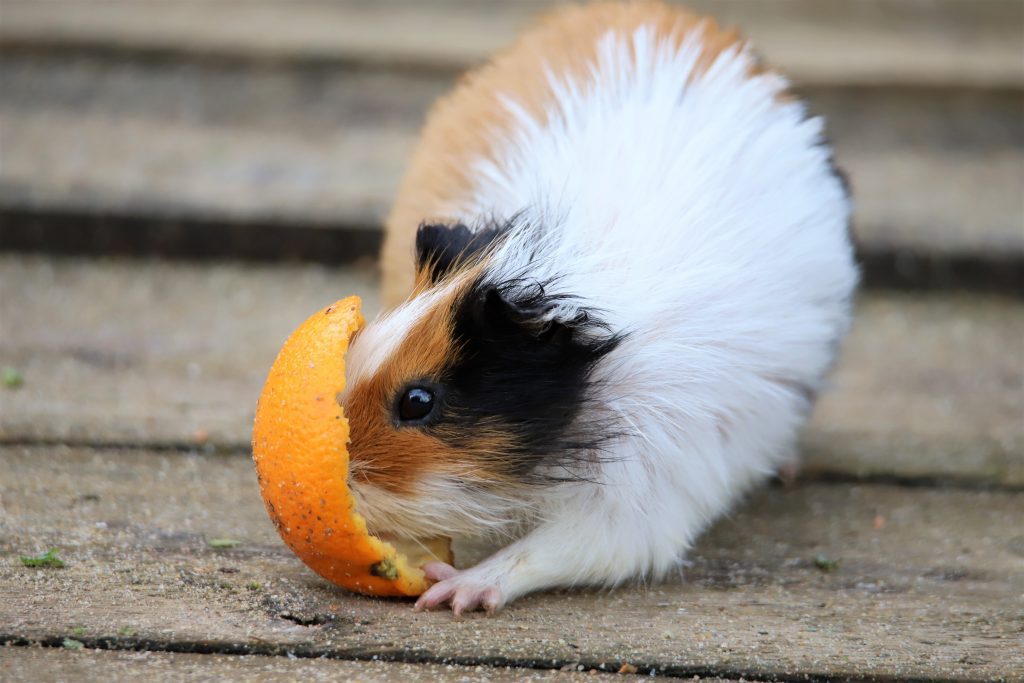
The evolutionary pattern shows that within a closely related group (“phylogenetic clade”), only the fruit-eating species have lost their functional vitamin C genes. In contrast, non-frugivorous species have kept their internal vitamin C production. This makes the “lost vitamin C genes” a trait that tends to evolve analogously as an evolutionary response to high fruit intake.

This phylogenetic tree by Drouin et al. (2011) illustrates the ability of different mammals to produce vitamin C. Dark green species produce vitamin C, light green species don’t produce vitamin C.
All apes (including humans) and most primates need to consume vitamin C from external sources (fruits). However, lemures are an exception in the primate family: Lemures still produce vitamin C themselves – and to no surprise, lemures “consume much fewer fruits than other primates,” as elaborated by Jason G. Goldman in this Scientific American article. Read the whole article on vitamin C and frugivores here.
2. Trichromatic color-vision is a trait specific to frugivores.
Most frugivores, including humans, see more colors than other species – a trait called trichromacy. This color-vision characteristic is optimized for detecting fruits (Regan et al., 1998) and “has evolved to contrast against background leaves in response to visual capabilities of local seed disperser communities (frugivores)” (Nevo et al., 2018).
“Amongst mammals, primates are the only ones that possess true trichromatic color vision. “
Carvalho et al. 2017

To be efficient in foraging fruits, frugivores can see more colors than non-frugivorous omnivores, herbivores, or carnivores. It is much harder to spot purple, orange, and pink colored fruits in a green canopy without being able to see red colors! Additionally, the coloration gives us information on the ripeness of fruits at a glance – even from a distance.
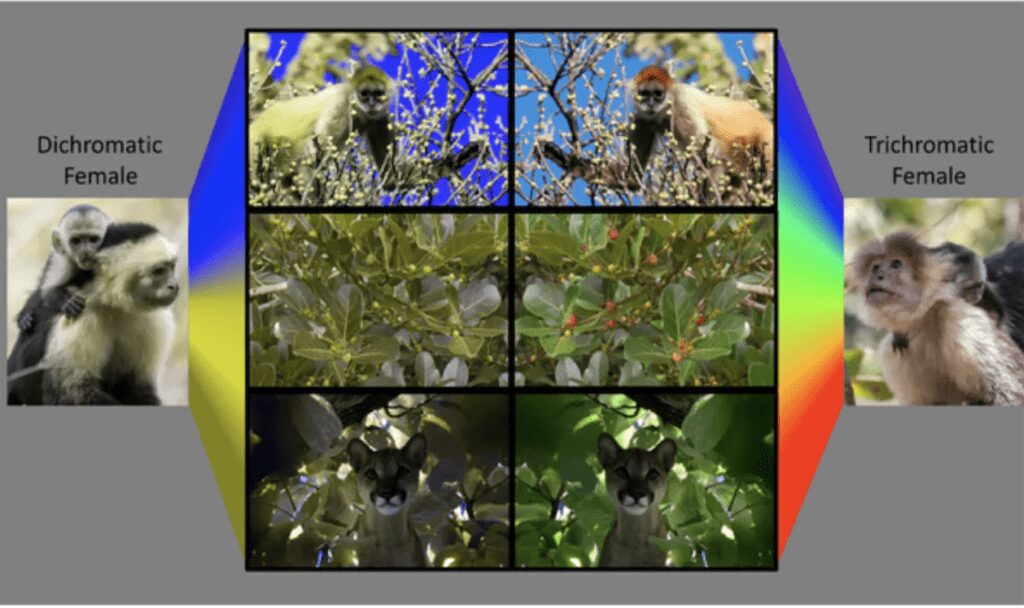
Illustration from the science journal PLOS ONE (Fedigan et al., 2014): Advantage of trichromatic color-vision for fruit foraging. See also an illustration in the journal nature on the effect of color-vision to distinguish colorful flowers within leaves (Hogan et al., 2018).
Our closely related ape family all share trichromatic color vision (Jacobs, 2007). However, not all primates have trichromatic color vision. A probable reason is that nocturnal species are not trichromatic.
3. Humans have the same digestive anatomy and microbiome as frugivorous apes.
Digestive anatomy is one of the key characteristics to determine the diet of an organism. Food is the driver behind the diversification of the digestive system (Karasov & Douglas, 2013). Whether humans have the digestion of omnivores or frugivores is somewhat controversial. However, the image of the high-meat-eating human is outdated and incorrect:
“Anthropoids, including all great apes, take most of their diet from plants, and there is a general consensus that humans come from a strongly herbivorous ancestry. Though gut proportions differ, overall gut anatomy and the pattern of digestive kinetics of extant apes and humans are very similar.”
K. Milton, 1999
The overall structure of gut morphology is highly similar in all apes and primates, with some differences in proportions, which actually are influenced by the diet itself rather than genetics (K. Milton, 1999). This means that the diet we eat shapes the proportion of our gut. This plasticity is likely an effective adaptation that helps us digest different types of foods. After all, we are frugivorous omnivores and able to survive on different types of food matter. It also means that the differences found in humans and chimpanzees are partly (or fully) due to environmental impacts – our crappy, cooked, modern diets, to be precise. Similar to the microbiome (see below).
Humans have the intestinal mucosa of a typical frugivore!
The gastrointestinal mucosa absorbs nutrients and is adjusted to the type of food an animal has to digest. Therefore, its size is characteristically for the diet type. In humans, the allometric size of the GI mucosa is specific for a frugivorous primate. Therefore, humans are grouped with the frugivorous primates, not with the folivorous (specialized in eating leaves) nor faunivorous (animal-matter-eaters) primates (read more here). While frugivorous primates do include some animal-based foods and even meat, occasionally, their main food source is fruit and other plant matter. Their main protein sources are nuts and greens.
Humans have the microbiome of a typical frugivore!
Humans have been shown to have a nearly identical microbiome to wild (frugivorous) chimpanzees when living in a natural environment (Gomez et al., 2019). What changes our microbiome is a “modern” polluted environment and diet (Sharma et al., 2020). Thus, humans naturally have a microbiome typical for a frugivorous primate! Thus, it comes as no surprise that high vitamin C and fruit intake change the microbiome to our benefit:
“High-dose vitamin C supplementation for two weeks shows microbiota-modulating effects in healthy individuals, with several beneficial shifts of bacterial populations.”
Otten et al. 2021
But why? What’s so special about high dosages of vitamin C? Because, in nature, frugivores get much more than we do on a modern diet! A 60kg chimpanzee takes in around 2000 mg of vitamin C, dogs get the same amount from internal production, while for humans, the recommended amount is only 75 mg. A recommendation that is often criticized for being too low! An adult should obtain around 2000 – 3000 mg of vitamin C daily when we compare humans to other mammals. This also explains why the effective (so-called) high vitamin C supplementation is not really “high” but rather the amount we should naturally get from diet. Read more here.
4. Humans have teeth typical for frugivorous primates.
Human teeth have the same overall dental pattern as other frugivorous apes and primates. Teeth are the most important tool in food intake and foraging. Their shape essentially defines their function and what type of food we can process effectively. Frugivores take bites with incisors and chew their foods with the molars while releasing sugar-digesting enzymes in their saliva. But when comparing frugivorous dentition to the dentition of other dietary types – like omnivores or herbivores – a few pictures will tell a lot:
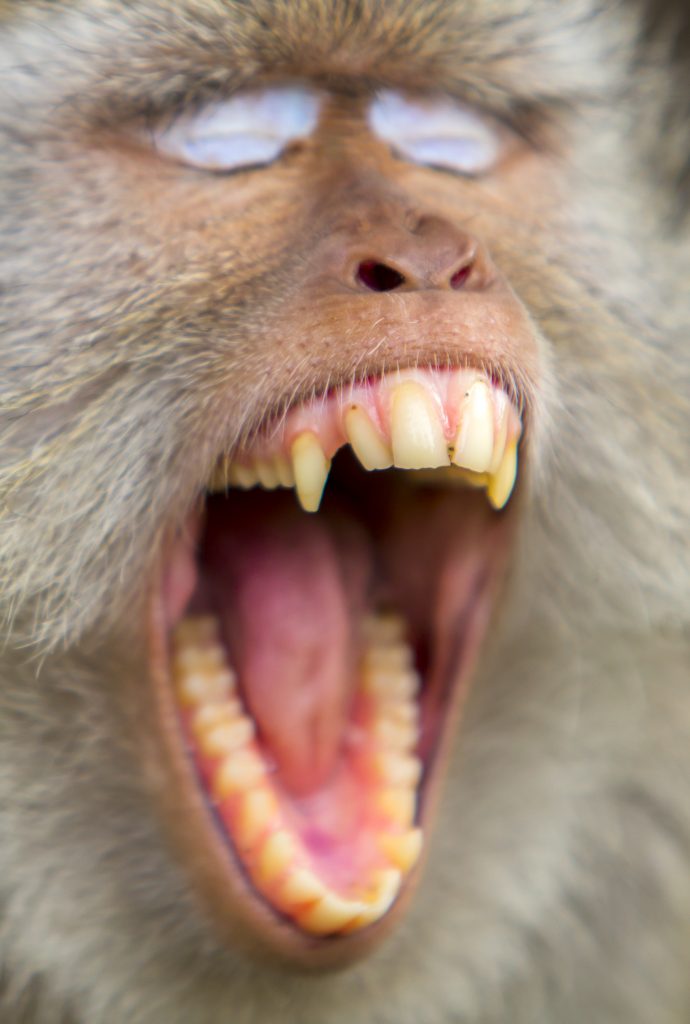
The teeth and dental structure of primates eating a high-fruit diet are very similar because “form follows function” in biology.
Take as an example the “long-tailed macaque” living in South Asia. They are classified as omnivores because they eat fruits, leaves, fungi, and insects and also are known to eat crabs. Their preferred food, however, is fruits. It makes up the majority of its diet. Thus, this primate species is also a frugivore – with a dental structure adapted to eat fruits.
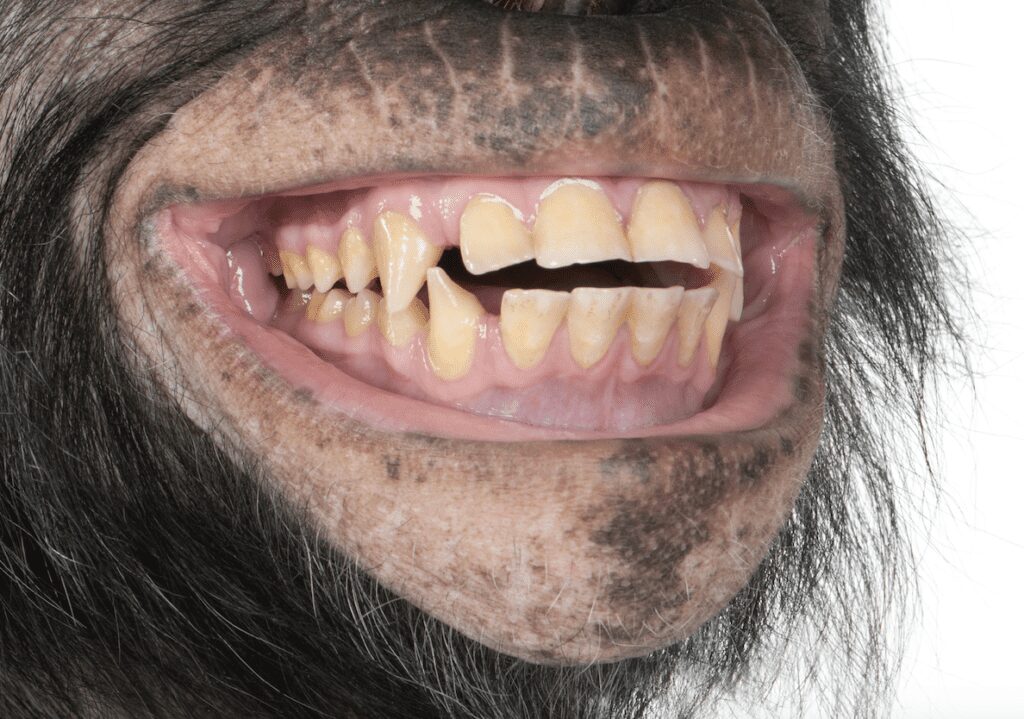
This is the dentition of a frugivorous chimpanzee, which is very similar to humans. See a detailed comparison between human and chimp teeth here.
This understanding is not new to anthropologists or to the public. In 1979, The New Your Times published an article called “Teeth Show Fruit Was The Staple” and stated, “PRELIMINARY studies of fossil teeth have led an anthropologist to the startling suggestion that early human ancestors were not predominantly meat eaters or even eaters of seeds, shoots, leaves or grasses. Nor were they omnivorous. Instead, they appear to have subsisted chiefly on a diet of fruit.” (source)
5. Instincts tell us what looks and tastes like actual food in nature – mainly fruits!
Besides sweetness, there are other sensory cues that instinctively attract us to fruits. Why do we perceive colorful fruits, especially tropical ones, as extraordinarily appealing and beautiful in their natural state? Because we are biologically adapted to those fruits, which do not need any cooking or flavoring for us to love them in their ripe form. They smell and taste good, too! Those are all instincts that naturally guide us – like other animals.
We instinctually know that fruits are good for food, and to no surprise, wild tropical fruits are edible for us (Sayago-Ayerdi, 2021) – unlike wild temperate fruits, which evolved as food sources for birds (read more here). Unfortunately, most of us have never experienced (or even thought about) the abundance, variability, and nutritious value of tropical fruits – which is the fundament of a frugivorous diet for primates.
Never even having seen or tasted the abundance of tropical fruits is probably the number one reason tha we have forgotten that we are frugivores.
As infants (after the lactation period) we are already instinctually attracted to sweet and colorful fruits, and sweet fruits are one of the first foods we can feed the little ones.
And if you like a small, convincing experiment about how important and strong instincts are, try feeding any cat some mangoes pieces…
Are humans adapted to cooked foods?
Generally, in nature, everything that is appealing straight from nature is a species’ naturally suitable food – this instinct is the key for every animal to know what to eat in the wild. Theoretically, everything that needs to be cooked to become edible or seasoned to be palatable and appealing is not natural human food. However, have we evolved with cooked foods so that we can no longer be sustained by a raw diet? Unlike chimpanzees? The very short answer is no… but this topic calls for another article; see here.
6. Humans have a sweet tooth – for a good reason!
Taste receptors for sweetness are not random: they have evolved to detect energy-rich sugars in fruits. All frugivorous primates crave sweet foods.
Instinctual knowledge is important in determining a species’ natural diet. In the case of frugivores, detecting sweet taste – and actually loving it – is the instinctual intelligence that motivates them (us) to eat ripe sweet fruits. What gives fruits the sweet taste are simple sugars, which are our primary energy source provided by the fruits. For us, liking sweets is natural and seems normal, but not all animals are able to taste sweetness! Especially species with a high meat intake have lost their ability to taste sweet (read more here). Humans, on the other hand, do not find a raw, fresh piece of meat appealing or tasty. Quite to the contrary, just looking at meat and blood is repulsive to most of us! This is why we do not take a trip to a slaughterhouse with our kids but will happily take them along with us to collect cherries or mangoes.
“…children’s liking for all that is sweet is not solely a product of modern-day technology and advertising but reflects their basic biology…(which) may have ensured the acceptance of sweet-tasting foods, such as mother’s milk and fruits.”
Ventura & Mennella, 2011
“Humans clearly come from an evolutionary past in which hexose (fructose) – rather than sucrose-dominated fruits were consumed, and human digestive physiology should, therefore, be best adapted to a carbohydrate substrate similar to that of wild fruits.”
Kathrine Milton; 1999
7. Frugivores like sour taste.
Acidic taste is off-putting for most animals – but not for frugivorous humans, apes, and birds! Just like sweet taste, humans enjoy sour taste. Most animals reject sour foods! We share our preference for slightly sour with all apes and the frugivorous monkeys as well as birds. Once more, this is a typical feature for frugivorous species, as most fruits have some acidic, sour flavor to them. (This phylogenetic tree by Frank et al. (2022) shows acid detection and preference in different animal species.)
Being attracted to acidic foods could be linked to the vital necessity to get vitamin C (ascorbic acid) via the diet: sour is a good indication of vitamin C in the food. Thus, vitamin C detection and attraction could be vital and adaptive in species without functional vitamin C genes (see above).
8. Humans have complex hands optimized for fruit foraging
Complex hands are the perfect tools for picking fruits from trees, determining ripeness, and peeling. To get the scope of this, picture picking and peeling fruits with a snout or paws will not work well – speaking from my own observation of my berry-eating dog!
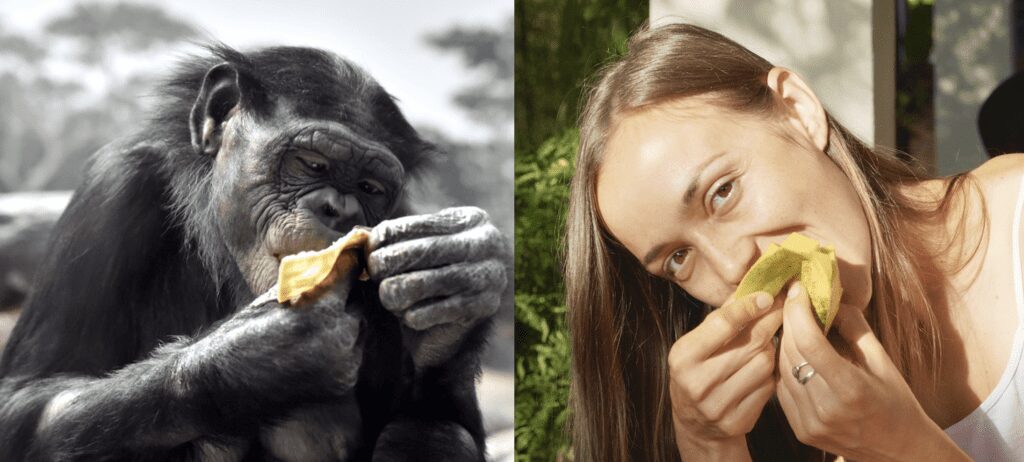
As explained above, a sophisticated, functional characteristic – such as a complex hand – does not happen by chance as explained by Kimbra Cutlik in the Smithonian Insider:
“Developing such complex hands was a costly evolutionary feat, requiring not only anatomical changes to the wrist and fingers, but also expanded nervous tissue to process sensory and motor signals between fingers and brain.”
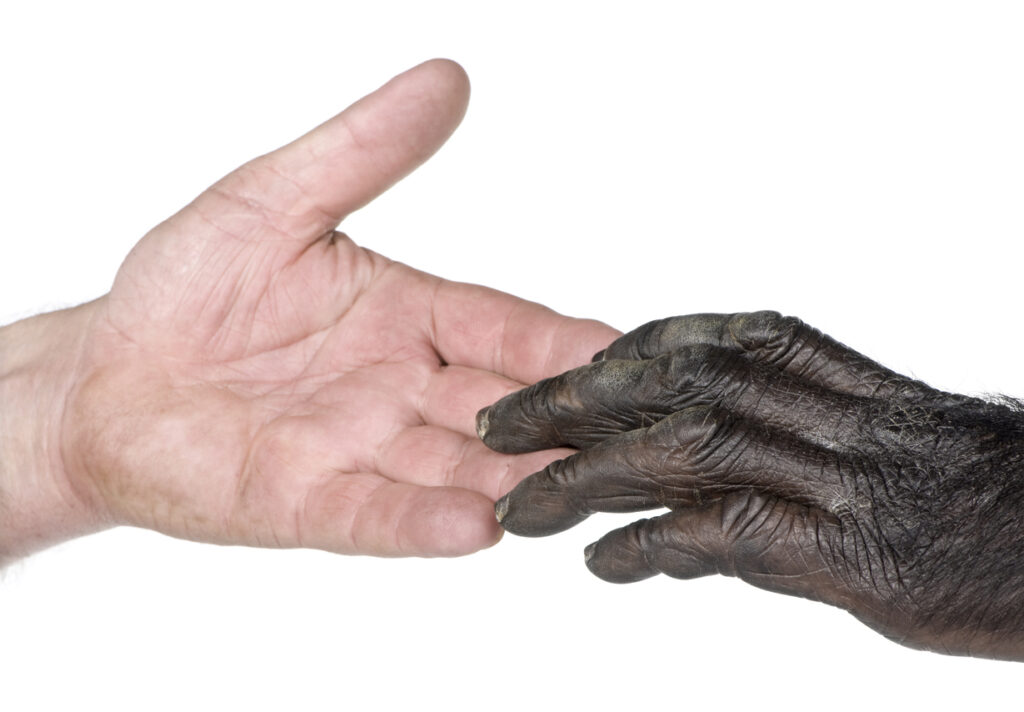
What about climbing skills and arboreal skills?
Opposable thumbs allow animals to grab and hold things and enable climbing. Paws and hooves can’t do that!
Primates share this trait (analogously) with other arboreal (tree-living) species like pandas, squirrels, koala bears, and opossums (to name a few). But do humans have the climbing traits and skills for an arboreal life and, thus, for a fruit diet?
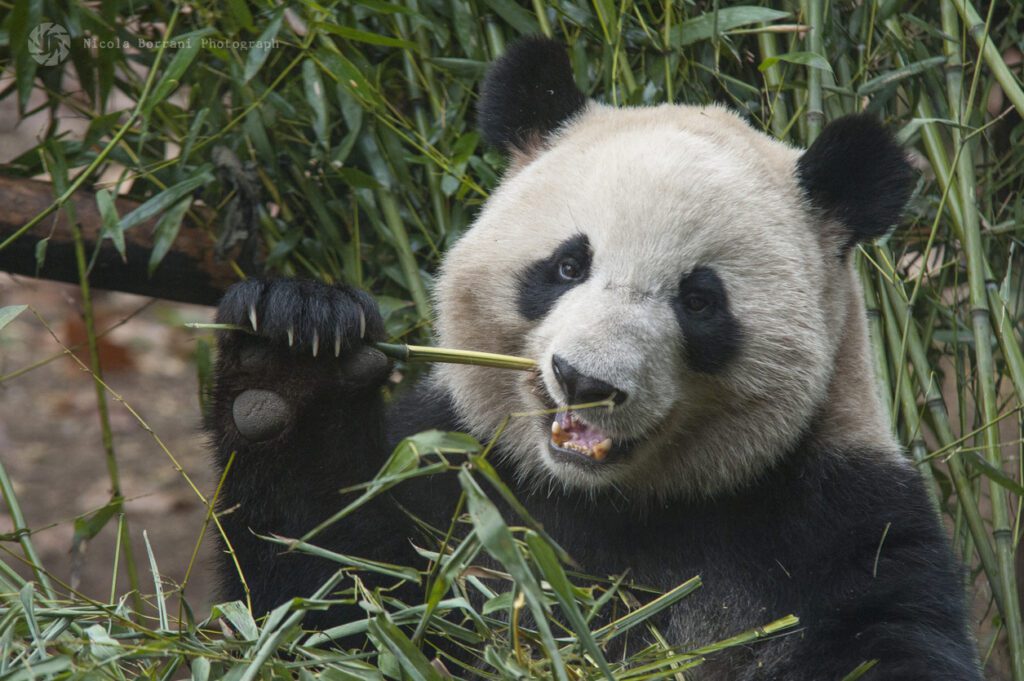
Humans have been argued to have reduced skills for arboreal life, i.e., tree climbing, but better adaptations of terrestrial bipedal life due to our “reduced” grip of the feet. However, it’s likely that through tree climbing training – since early childhood – arboreal life and fruit foraging seems possible. Thus the extent of possible arboreality of humans is still an open question in science.

“Our findings challenge the persistent arboreal–terrestrial dichotomy that has informed behavioral reconstructions of fossil hominins and highlight the value of using modern humans as models for inferring the limits of hominin arboreality.”
Venkataraman et al, 2012
Further, reduced climbing skills per se is not generally a prove against humans being frugivores:
- Frugivores can be terrestrial (ground-living), too. (Havmøller, 2021)
- Bipedalism (walking upright on two feet) is also used on trees and has not necessarily evolved due to terrestrial living (read more here). This gives off some serious Avatar vibes?!
- Adapting to new challenging conditions (fallback foods) does not necessarily mean maladaptations to the prior conditions (high-fruit).
This, admittedly, is speculative, but in evolution, we need to consider different scenarios to reconstruct the real picture! Despite adaptations to terrestriality (living on the ground), cooked foods, and cold climates, humans still have distinctive traits that have evolved with a high-fruit diet. This is a fact that is widely ignored in human nutrition and comparative evolution.
9. We are a tropical species – the only habitat where bigger frugivores can survive!
Humans come from tropical ancestry and are actually still a tropical species. Only the tropics sustain larger frugivorous animals. Thus, generally, frugivorous mammals are found in the tropics.
Large frugivores are exclusively tropical-native species. Why? Because only tropical conditions provide highly nutritious fruits throughout the entire year, as opposed to seasonal and cold climates. Thus, in temperate or colder climates, we obviously cannot survive on mostly fruits.
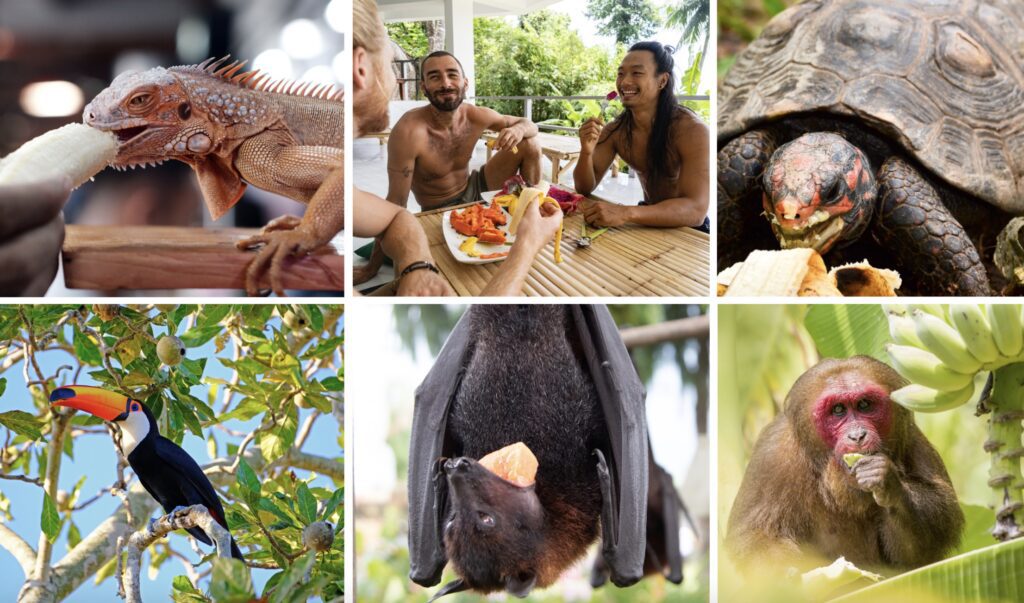
Also, the lack of major biological cold adaptations shows that humans are a tropical species. We just manage to live outside the natural habitat because of our intelligent ability to shape cold environments into survivable conditions (heating, cooking, clothing, etc.). The “tropical human” is also supported by fossil records, which point toward humans being a species that originated in tropical Africa (Daanen, 2016).
Us being a tropical species is another indication that frugivory in humans is a real possibility, which is why most wild tropical fruits are edible for humans!
10. Humans originated in forests – not the savanna!
It turns out the human past was quite different than the slow transition from tropical forest to the open savannah: new insights question the paradigm and suggest that we indeed originated in forests! This has huge implications for our diet. Forests provide fruits, while the savannah – and cold habitats – is a habitat that requires hunting. Humans are a tropical species, and our ancestors have adapted to unsuitable habitats through culture and intelligence rather than genetic adaptations. Read more here.
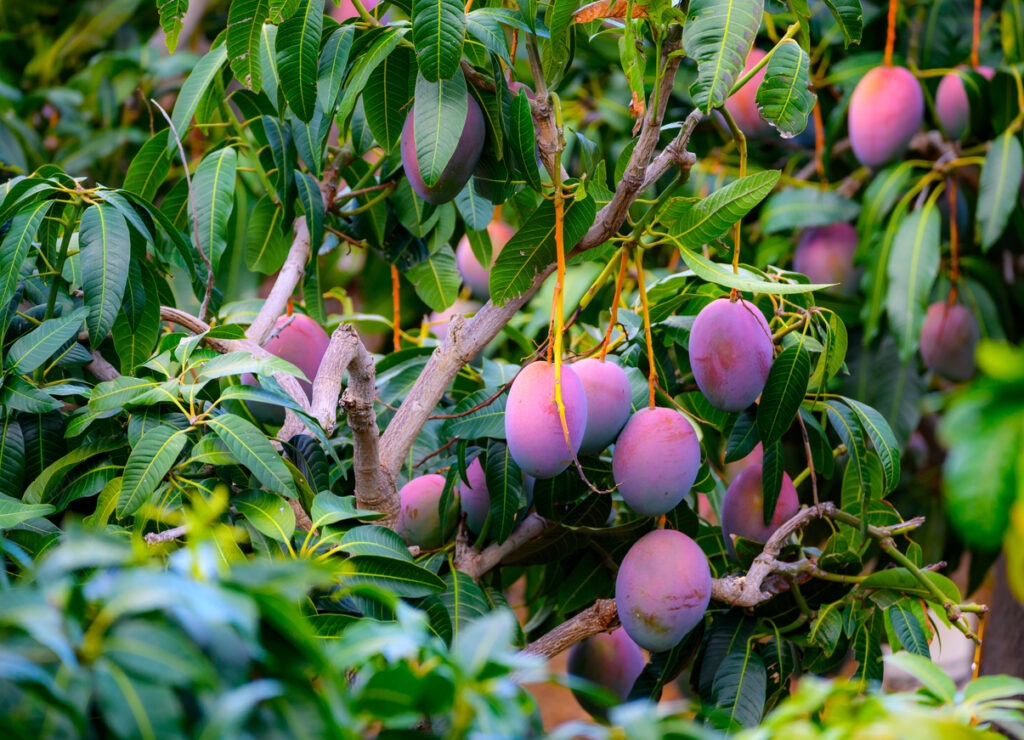
Conclusion
Comparing and analyzing dietary adaptations is a valuable tool for exploring our species-specific diet and has undoubtedly been a neglected discipline compared to paleoanthropological studies of our recent hunter-gathering ancestors (read more here). Humans have many adaptive features that specialize us as fruit-eaters. But are we still as frugivorous as chimpanzees? More scientists should ask this essential question! And as a follow-up question: “What can we learn from wild primate diets?” which is reflected in this citation from primate nutrition researcher Kathrine Milton:
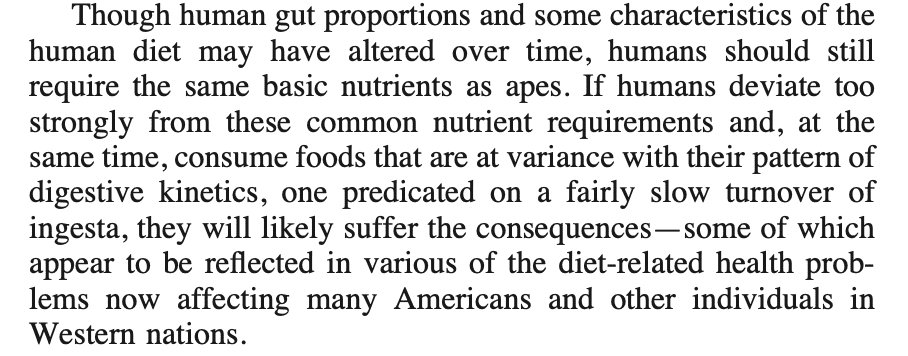
Knowing the human biological species-appropriate diet matters: the enormous ramifications for dietary recommendations and habits, health, and the view on chronic diseases only become clear once we can see how wrongly we have eaten from a biological perspective. Most of us live entirely out of our natural habitat, which is why knowing the natural human diet is challenging. If we have never experienced the abundance, flavors, and nutritional quality of high-quality tropical fruits, it is hard to imagine that we can live on mostly fruits.
But when we have a deeper look at our origins, we will find that we do not only share most genes with our closest relatives but also much of their dietary adaptations and, therefore, our natural diet! Real-life experience and science have continuously and reliably shown the plethora of health benefits of tropical fruits and a high fruit intake. It should now make more sense as to why this is: the biologically appropriate diet of our species – the natural human diet – is fruit-based.
References
- T. Matsui, Vitamin C nutrition in cattle. Asian-Australasian Journal of Animal Sciences. 25, 597–605 (2012), doi:10.5713/ajas.2012.r.01.
- T. H. Jukes, J. L. King, Evolutionary loss of ascorbic acid synthesizing ability. Journal of Human Evolution. 4, 85–88 (1975), doi:10.1016/0047-2484(75)90002-0.
- G. Drouin, J.-R. Godin, B. Page, The genetics of vitamin C loss in vertebrates. Current Genomics. 12, 371–378 (2011), doi:10.2174/138920211796429736.
- J. G. Goldman, Why lemurs have such strange diets. Scientific American (2018) (available at https://www.scientificamerican.com/article/why-lemurs-have-such-strange-diets/).
- Trichromacy. Wikipedia (2023) (available at https://en.wikipedia.org/wiki/Trichromacy#Humans_and_other_animals_that_are_trichromats).
- B. C. Regan et al., Frugivory and colour vision in Alouatta Seniculus, a trichromatic Platyrrhine Monkey. Vision Research. 38, 3321–3327 (1998), doi:10.1016/s0042-6989(97)00462-8.
- O. Nevo et al., Frugivores and the evolution of Fruit Colour. Biology Letters. 14, 20180377 (2018).
- Carvalho, L.S. et al. (2017) ‘The genetic and evolutionary drives behind Primate Color Vision’, Frontiers in Ecology and Evolution, 5. doi:10.3389/fevo.2017.00034.
- L. M. Fedigan, A. D. Melin, J. F. Addicott, S. Kawamura, The heterozygote superiority hypothesis for polymorphic color vision is not supported by long-term fitness data from Wild Neotropical Monkeys. PLoS ONE. 9 (2014), doi:10.1371/journal.pone.0084872.
- J. D. Hogan, L. M. Fedigan, C. Hiramatsu, S. Kawamura, A. D. Melin, Trichromatic perception of flower colour improves resource detection among New World Monkeys. Scientific Reports. 8 (2018), doi:10.1038/s41598-018-28997-4.
- G. H. Jacobs, The comparative biology of photopigments and color vision in primates. Evolution of Nervous Systems, 79–85 (2007), doi:10.1016/b0-12-370878-8/00009-4.
- W. H. Karasov, A. E. Douglas, Comparative digestive physiology. Comprehensive Physiology, 741–783 (2013), doi:10.1002/cphy.c110054. (link)
- K. Milton, Nutritional characteristics of wild primate foods: Do the diets of our closest living relatives have lessons for us? Nutrition. 15, 488–498 (1999), doi:10.1016/s0899-9007(99)00078-7. (full text)
- Milton, K. (1999) ‘A hypothesis to explain the role of meat-eating in human evolution’, Evolutionary Anthropology: Issues, News, and Reviews, 8(1), pp. 11–21. doi:10.1002/(sici)1520-6505(1999)8:1<11::aid-evan6>3.0.co;2-m.
- C. M. Hladik, D. J. Chivers, P. Pasquet, On diet and gut size in non‐human primates and humans: Is there a relationship to brain size? Current Anthropology. 40, 695–697 (1999), doi:10.1086/300099.
- Otten, A.T. et al. (2021) ‘Vitamin C supplementation in healthy individuals leads to shifts of bacterial populations in the gut—a pilot study’, Antioxidants, 10(8), p. 1278. doi:10.3390/antiox10081278.
- A. Gomez et al., Plasticity in the human gut microbiome defies evolutionary constraints. mSphere. 4 (2019), doi:10.1128/msphere.00271-19.
- A. K. Sharma et al., Traditional human populations and nonhuman primates show parallel gut microbiome adaptations to analogous ecological conditions. mSystems. 5 (2020), doi:10.1128/msystems.00815-20.
- Kristina Cawthon Lang, Primate Factsheets and Resources (2006) (available at https://primate.wisc.edu/primate-info-net/pin-factsheets/).
- Kimbra Cutlik, Did ripening fruit help hominids develop complex hands? (2016) Smithsonian Insider (available at https://insider.si.edu/2016/05/did-ripening-fruit-help-hominids-develop-complex-hands/).
- V. V. Venkataraman, T. S. Kraft, N. J. Dominy, Tree climbing and human evolution. Proceedings of the National Academy of Sciences. 110, 1237–1242 (2012), doi:10.1073/pnas.1208717110.
- L. W. Havmøller et al., Arboreal monkeys facilitate foraging of terrestrial frugivores. Biotropica. 53, 1685–1697 (2021), doi:10.1111/btp.13017.
- S. Magazine, Human ancestors may have evolved to walk upright in trees. Smithsonian.com (2022) (available at https://www.smithsonianmag.com/smart-news/human-ancestors-may-have-evolved-to-walk-upright-in-trees-180981300/).
- Vicki Contie, Carnivores lack taste for sweets. National Institutes of Health (2012) (available at https://www.nih.gov/news-events/nih-research-matters/carnivores-lack-taste-sweets).
- Ventura, A.K. and Mennella, J.A. (2011) ‘Innate and learned preferences for sweet taste during childhood’, Current Opinion in Clinical Nutrition and Metabolic Care, 14(4), pp. 379–384. doi:10.1097/mco.0b013e328346df65.
- S. Sayago-Ayerdi, D. L. García-Martínez, A. C. Ramírez-Castillo, H. R. Ramírez-Concepción, M. Viuda-Martos, Tropical fruits and their co-products as bioactive compounds and their health effects: A Review. Foods. 10, 1952 (2021).
- Frank, H.E. et al. (2022) “The evolution of sour taste,” Proceedings of the Royal Society B: Biological Sciences, 289(1968). Available at: https://doi.org/10.1098/rspb.2021.1918.
- H. A. M. Daanen, W. D. Van Marken Lichtenbelt, Human whole body cold adaptation. Temperature. 3, 104–118 (2016), doi:10.1080/23328940.2015.1135688.
- Scerri, E.M. et al. (2022) Tropical forests in the deep human past. Philosophical Transactions of the Royal Society B: Biological Sciences, 377(1849). doi:10.1098/rstb.2020.0500.
Last updated on:


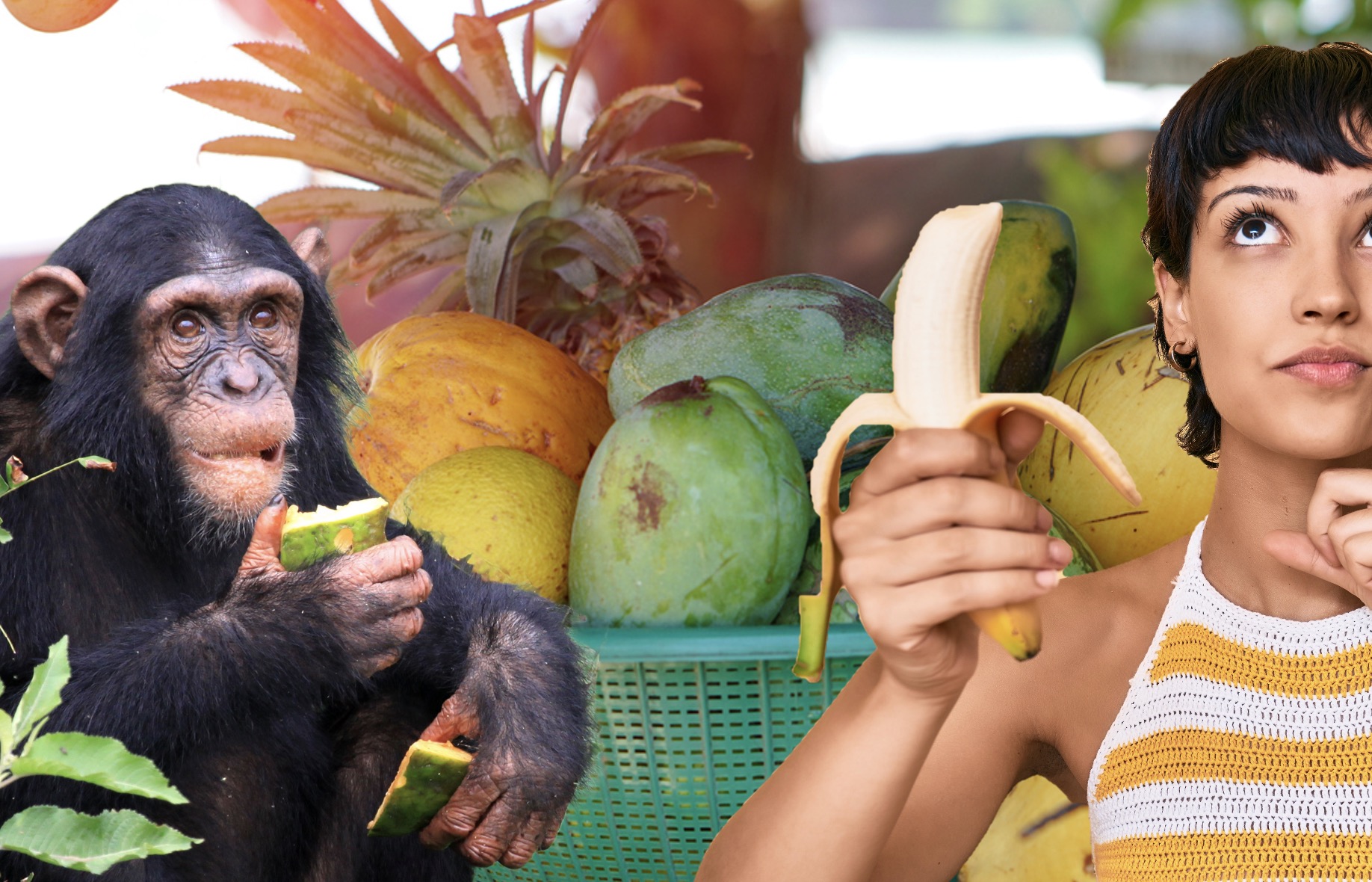
Add Comment